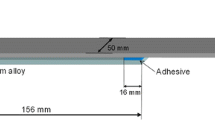Abstract
In this paper, the results of a publicly funded project will be presented. The aim of this project is to investigate the use of two-component (2C), crash-modified (CM) adhesives for joining fibre-reinforced plastics (FRPs) in the process of body in white (BIW). For the assembly of car bodies, special structural adhesives are necessary, combining high strength with the ability to dissipate energy in case of crashes. Most of the used adhesives are single-component (1C) and cure thermally. 2C adhesives which cure at room temperature and are currently used for maintenance and repair feature many benefits compared to hot curing 1C systems in the online BIW production process. However, until now, the application of CM 2C adhesives used to join FRP has not been sufficiently examined, especially with regard to the cataphoretic process. Therefore, this work investigates different process parameters in the BIW production process, which influence the properties of the selected crash-optimised 2C adhesives as well as the characteristics of the bond. The selected 2C adhesives were characterised with respect to their quasi-static and dynamic properties under conditions that occur in the cataphoretic process and application. For mixed materials and the temperature program in the CDP process, shear stresses and strains influence the performance of the bond. Therefore, measurements were carried out to evaluate the effects caused by the temperature program. Furthermore, the methods of differential scanning calorimetry (DSC) and dynamic mechanical analysis (DMA) were used to demonstrate effects of the BIW process on the adhesive properties as well as the ability of 2C adhesives to be fast cured at elevated temperatures.













Similar content being viewed by others
References
Eichleiter F (2012) Fertigungs- und prozessbedingte Eigenschaften von Klebverbindungen im Karosseriebau. Forschungsberichte des Instituts für Füge- und Schweißtechnik, Volume 29. Shaker Verlag, Aachen
Pujol S (2012) Multi-material adhesive joining in the automotive sector. Adv Struct Mater 8:195–217
Wilke G (1999) Lackieren von Kunststoffanbauteilen. Kunststoffe 89(3):88–94
Lutz A (2009) So gut wie neu – Crashstabile 2K-Reparaturklebstoffe. Adhäsion Kleben und Dichten 53(6):20–21
Frauenhofer M, Appelt M, Kreling S, Böhm S, Dilger K (2009) Wirtschaftliches Fügen in Serie und Reparatur – Schnellaushärtung struktureller Klebstoffe (Teil 2). Adhäsion Kleben und Dichten 53(01–02):36–41
Hart-Smith LJ (2011) Adhesively bonded joints in aircraft structures. In: da Silva LFM, Öchsner A, Adams RD (eds) Handbook of adhesion technology, vol 2. Springer, Berlin, pp 1103–1184
Blackmann BRK, Kinloch AJ, Taylor AC, Wand Y (2000) The impact wedge-peel performance of structural adhesives. J Mater Sci 35:1867–1884
Acknowledgments
The Department for Cutting and Joining Manufacturing Processes would like to thank the accompanying committee for their excellent support. The research project (DVS No. 08.086, IGF No. 17.778N) of the DVS was funded through the program for the promotion of the “Industrial Community Research (IGF)” by the Federal Ministry of Economics and Technology through the AIF. This assistance is gratefully acknowledged.
Author information
Authors and Affiliations
Corresponding author
Additional information
Recommended for publication by Commission XVI - Polymer Joining and Adhesive Technology
Rights and permissions
About this article
Cite this article
Kahlmeyer, M., Böhm, S. Crash-modified two-component adhesives for joining CFRP and aluminium in automotive body in white. Weld World 60, 767–776 (2016). https://doi.org/10.1007/s40194-016-0329-5
Received:
Accepted:
Published:
Issue Date:
DOI: https://doi.org/10.1007/s40194-016-0329-5




